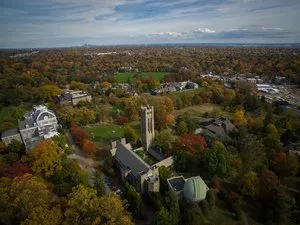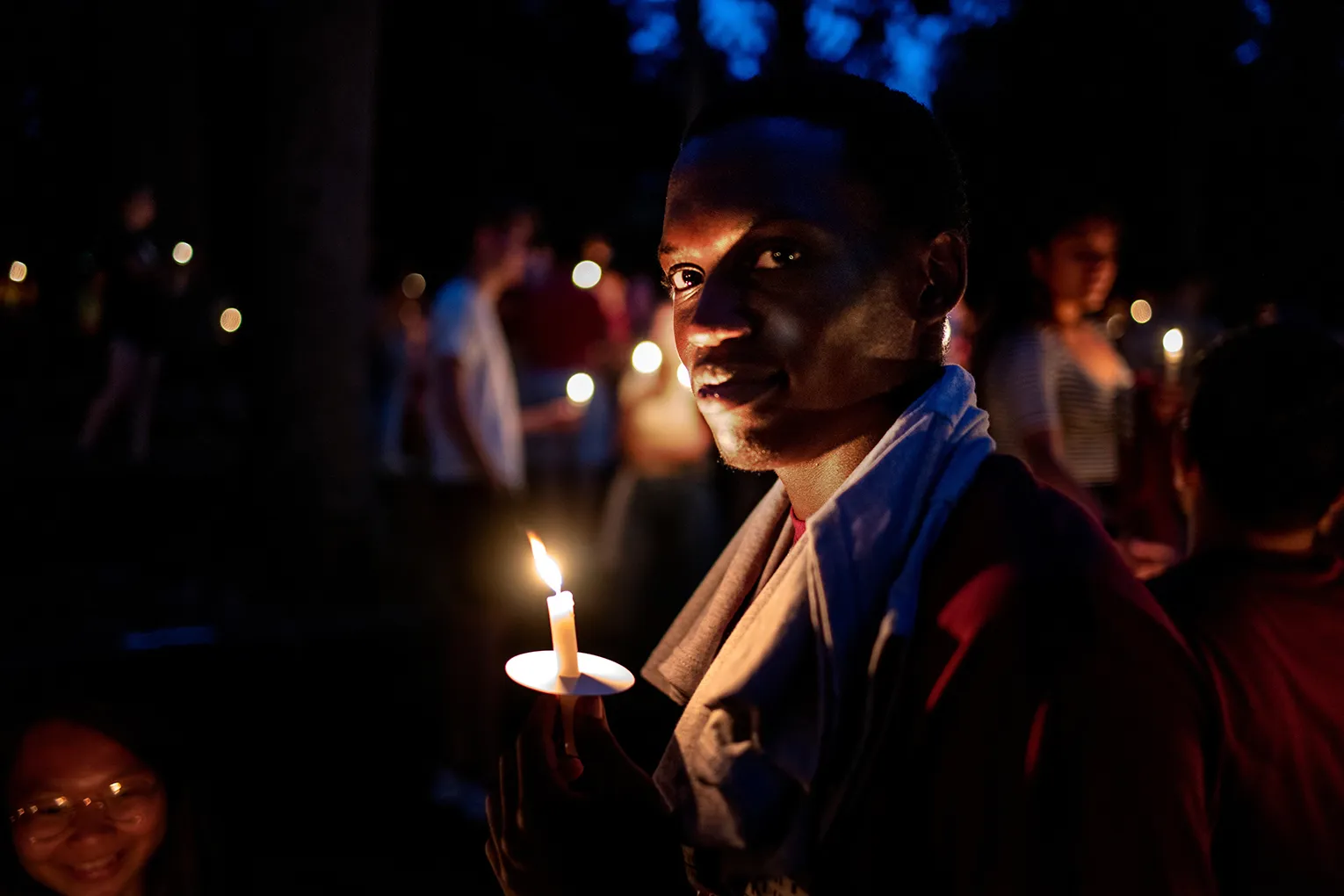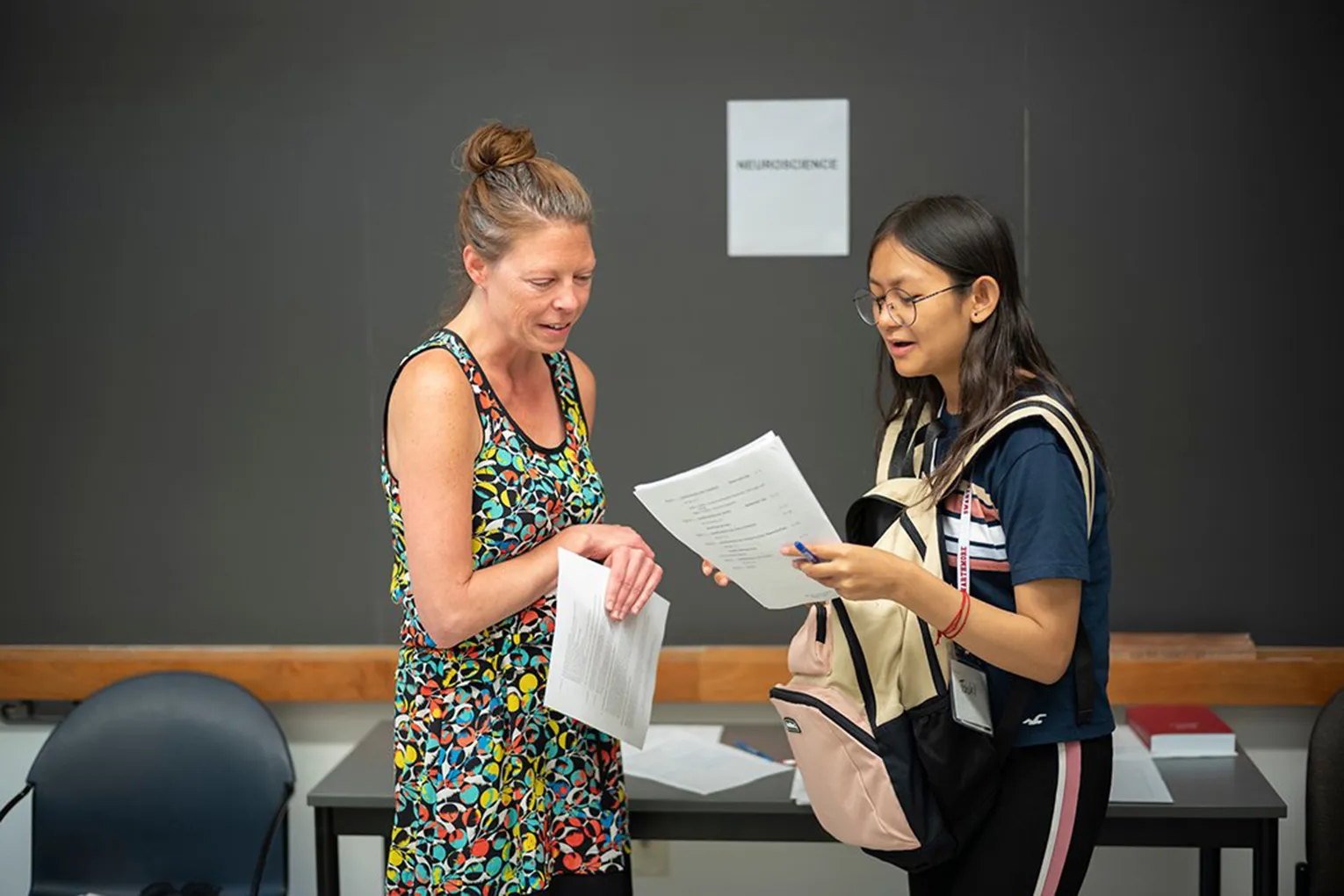Summary of the September 2025 Board Meeting
Dear Students, Faculty, and Staff Members,
I hope you’ve settled into the fall semester and that your academic year is going well. On behalf of Board of Managers Chair Koof Kalkstein ’78, I write today with a summary of the September Board meeting, which took place on campus this past weekend. I’d like to thank our student and faculty board observers, Luca Campiani ’26, and Associate Professor of Art History Patricia Reilly, for attending the general session on Saturday.
This was the first meeting for three new Managers: Michael Costonis ’92, Jyothi Das ’92, and Jim Sailer ’90, who joins the Board in his role as president of the Alumni Council. You can read more about these appointments on the College’s website. On behalf of the Swarthmore community, I would like to extend my gratitude to these alumni for volunteering their time and energy to the College.
The celebration of the opening of Martin Hall was a highlight of the weekend. As many of you are aware, the building has been reimagined as a new home for our departments of Computer Science and Film & Media Studies, as well as the Creative Media Commons. It is, in a word, stunning, and it was thrilling to hear from faculty and students who’ve had the opportunity to use this new space during the first few weeks of the year. The celebration was the culmination of years of thoughtful planning and meticulous work by many individuals. I am so grateful to all who contributed to this project, including our students, faculty, and staff members who provided important insights that informed the design and the programming needs, our colleagues on the Capital Planning and Project Management team, our construction partners, the generous donors who helped bring the project to fruition, and many others.
Fiscal Landscape
Typically, the Board approves the fiscal year budget in the spring. However, given the significant financial uncertainties we faced, the Board adopted an interim budget at its May meeting, delaying a decision on the full operating budget.
At this point, the most significant external financial threats in the spring have subsided or turned out better than we could have expected. For instance, the first-year class includes one of the largest international student cohorts in years. While four of our faculty members had research grants terminated, one was restored, and the College has covered the lost funding through other avenues, including donor support. In addition, we were able to avoid what would have been a devastating increase to the tax on our endowment earnings, and the new legislation exempts us from paying the tax at all, beginning in 2027. With more clarity around the issues that prompted the interim budget, the Managers have adopted the full 2025-26 budget.
While we are fortunate to operate from a position of relative fiscal strength and stability compared with many colleges and universities, we continue to face financial headwinds. These forces include a confluence of modest expected revenue growth, expenses rising above inflation, and ongoing uncertainty, largely resulting from the federal government’s stance toward higher education. For instance, some lawmakers in Washington have already signaled a desire to take up a second tax bill, which could reopen the endowment tax issue. And the risk of federal action targeting student visas, research grants, and other federal funding remains. We should not be deterred by these uncertainties, but we have to be thoughtful and proactive as we try to anticipate what might come our way.
Revenue and Expenses
Our largest source of revenue comes from the endowment, accounting for nearly 60% of our annual operating budget. The majority of that money supports priorities central to our mission, such as our need-blind financial aid program and capital renewal and improvement projects. Our next largest revenue source comes from tuition and related fees.
But our expenses are rising faster than our revenue sources can cover. The amount we spend from the endowment is near the upper limit of what our spending policy allows for. And while we’ve raised student tuition, food, housing, and fee charges, we work to minimize these increases to avoid putting more of a financial burden on students and their families who do not qualify for financial aid. We’ve run small deficits in the past several years and have covered such shortfalls with reserve funds, but that’s not a sustainable practice. We must exercise greater fiscal restraint moving forward.
2025-26 Budget
With that in mind, the fiscal year 2025-26 budget funds very modest growth over last year’s budget for important programs core to our mission. That includes more than $66 million for student financial aid, a 7% increase from last year; increases to faculty, staff, and student pay that were deferred in the interim budget; continued support for the pilot program that provides laptops to students on financial aid who need a computer; and additional funding for Counseling and Psychological Services to support student health and well-being. We will also continue to fund the student SEPTA Key Advantage UPass program without changes. And we will extend the Faculty and Staff SEPTA Key Advantage UPass pilot program with a small increase to the employee contribution — from $25 to $35 per month, effective Jan. 1, 2026. As a reminder, these programs give students, faculty, and staff members 240 rides each month on SEPTA’s network of subways, buses, trolleys, and Regional Rail lines.
At the same time, to offset rising costs, we’re making modest budget reductions in several areas, including travel, catering, professional development, memberships and subscriptions, and equipment purchases.
Budget managers will be able to view details in mySwarthmore early next week.
Benefits and Health Care Costs
We are invested in attracting and retaining talented faculty and staff members, including by offering highly competitive benefits and compensation. The cost of our faculty and staff benefits is significant, climbing to $36 million, a 9% increase from last year.
Health care benefits represent nearly half of those costs. We are committed to providing quality, affordable health care coverage to our faculty and staff members and their families, and we continue to offer a variety of insurance plans to fit the diverse needs of our community members. But health care costs are projected to rise to more than $20 million next year — a 73% increase since 2020.
The College will continue to cover more than 91% of these costs, ensuring that our cost-share model maintains Swarthmore as a leader in the benefits it provides, both among regional employers and our higher education peers. However, most faculty and staff members who are enrolled in one of our health insurance plans will see an increase in premiums starting in January 2026. The increases vary widely across the different plans and the tiers within each plan, with most falling between $1.50 per month to $38 per month. Some of you will see larger increases, including those on our premium PPO plan, depending on the tier you select. The Human Resources Office will include more details ahead of the open enrollment period in early October to help inform the plan you select for 2026.
2025-26 Pay Increases
Finally, I am pleased to share that the Board approved the following pay increases and fully supported our recommendation that they be retroactive to the dates when the increases would have taken effect had the full budget passed in May (July 1 for staff and August 1 for faculty).
- Staff Members: Staff members hired prior to April 1 will receive a 3.25% pay increase. Staff members hired between April 1 and May 31 will receive a prorated increase based on their hire date. (As a reminder, despite the interim budget, the Board did move forward with increasing the minimum wage for all hourly staff members to $20 per hour effective July 1. Staff members who received a pay raise at that time will not receive an additional increase.)
- Faculty and Instructional Staff Members: Benefits-eligible faculty and instructional staff members on continuing appointments from the 2024-25 academic year will receive an increase between 2.3% and 4.6%. These increases reflect the College’s long-standing commitment to pay faculty 102.5% of the average of our peer institutions. The Provost’s Office will communicate more details directly to department chairs, and faculty will be notified of their specific pay increases when salary letters become available in October.
- Student Workers: Effective Monday, September 28, all hourly student wage tiers will increase by 50 cents per hour, resulting in a student worker minimum wage of $15.50 per hour. The majority of student workers will earn between $16.25 and $17.00 per hour, based on the position responsibilities.
These increases will be reflected in your October paycheck(s). A lump sum payment to cover the retroactive pay will be included in your November paycheck(s). Please see the following Frequently Asked Questions on Payroll’s website for additional details. You can find the paycheck schedule there as well.
Gratitude
On behalf of the Board, please accept my gratitude and deep appreciation for the time, creativity, and care you dedicate to our students, to one another, and to advancing our shared mission.
Sincerely,
Val Smith
President



